Super Flatbedders Could I Get Some Advice
Topic 17904 | Page 2

The problem is that until we know what you are hauling there is no way we can give advice on how to secure it. All we can tell you is general guidelines and you are getting that in the securement training section.
Victor, I kind of agree with Pat on this - it is a little hard for us to tell you how to secure loads. That is something that you will learn at orientation. The main things you need to learn are what we call the WLL of each piece of your securement equipment. WLL stands for Working Load Limit. For example, a 4" strap has a WLL of 5,400 pounds.
Here's a former discussion we had on this subject that you may find useful. Take a look at this.
Also as far as tips go here is one that I have posted before in the variety thread that you may enjoy looking at...
When tightening a strap down on a load, you don't want to have eight or ten feet of your excess strap wrapped around your winch. The main reason is that in so doing you are creating a good bit of slack in that strap that will develop and continually get worse as you drive down the road. The slack is actually in the windings on the winch. You may very well get it as tight as you can with your load bar, only to find that 150 miles down the road it is loosened up quite a bit. The vibrations of the road or the forces of a hard break will definitely loosen up a strap that is secured that way. What you want to do is pass the end of your strap all the way through the winch and then fold up the excess end so that as you tighten your winch it will pinch the excess strap up against the body of the trailer or the freight. You want to try and not wrap more than maybe three wraps at the most onto your winch - one or two is optimal, and you will very seldom need to tighten that winch again unless you're freight is something that compresses from the road vibrations.
Here is a couple of photos to demonstrate what I'm talking about.
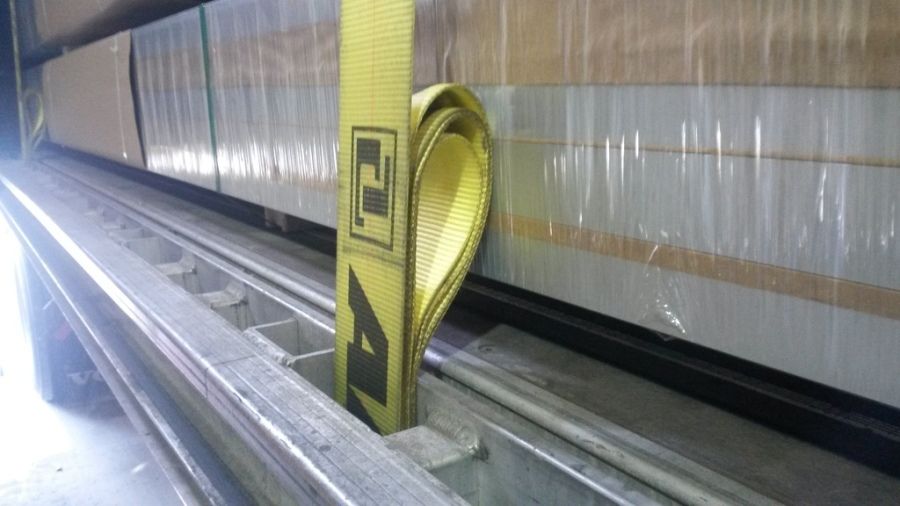
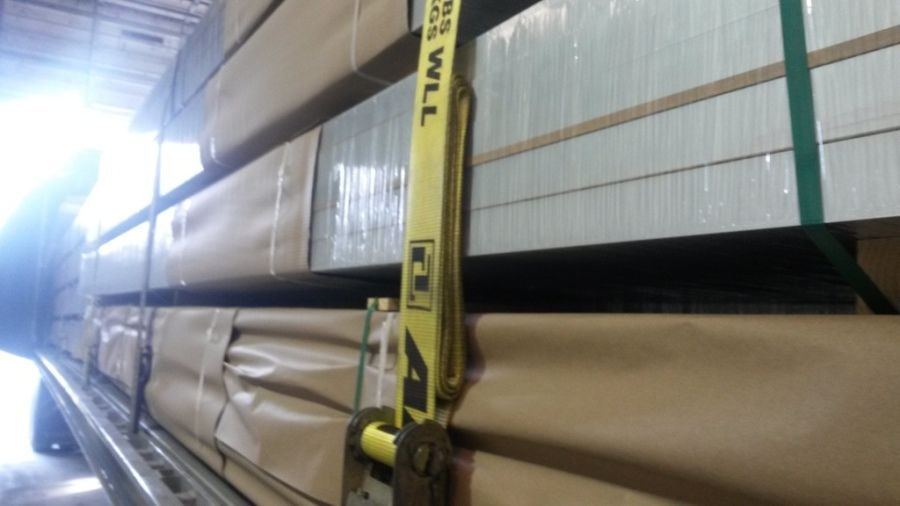
Occasionally I'll use a hand winch like that second photo above. I do this when I need a winch in an area that is just above a tire. Putting the sliding rail mounted winch just above a tire is never a good idea, especially if there isn't a lot of room for the suspension to travel up and down. I've actually seen a guy lose a part of his flat-bed load because his tire came up and severed the strap which he had wound around his winch so much that it was protruding from the winch. After several times of the tire rubbing the strap it eventually gave way and then he found himself in some deep doo-doo!
You definitely don't want to get yourself into a situation like this poor fellow from Buchanan Haulers...
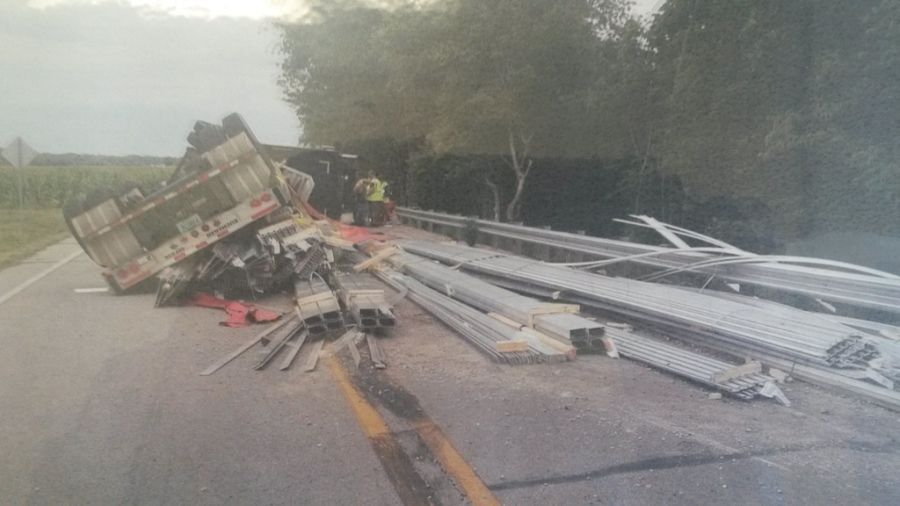
OTR:
Over The Road
OTR driving normally means you'll be hauling freight to various customers throughout your company's hauling region. It often entails being gone from home for two to three weeks at a time.
OOS:
When a violation by either a driver or company is confirmed, an out-of-service order removes either the driver or the vehicle from the roadway until the violation is corrected.
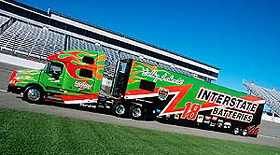
Victor, I kind of agree with Pat on this - it is a little hard for us to tell you how to secure loads. That is something that you will learn at orientation. The main things you need to learn are what we call the WLL of each piece of your securement equipment. WLL stands for Working Load Limit. For example, a 4" strap has a WLL of 5,400 pounds.
Here's a former discussion we had on this subject that you may find useful. Take a look at this.
Also as far as tips go here is one that I have posted before in the variety thread that you may enjoy looking at...
When tightening a strap down on a load, you don't want to have eight or ten feet of your excess strap wrapped around your winch. The main reason is that in so doing you are creating a good bit of slack in that strap that will develop and continually get worse as you drive down the road. The slack is actually in the windings on the winch. You may very well get it as tight as you can with your load bar, only to find that 150 miles down the road it is loosened up quite a bit. The vibrations of the road or the forces of a hard break will definitely loosen up a strap that is secured that way. What you want to do is pass the end of your strap all the way through the winch and then fold up the excess end so that as you tighten your winch it will pinch the excess strap up against the body of the trailer or the freight. You want to try and not wrap more than maybe three wraps at the most onto your winch - one or two is optimal, and you will very seldom need to tighten that winch again unless you're freight is something that compresses from the road vibrations.
Here is a couple of photos to demonstrate what I'm talking about.
Occasionally I'll use a hand winch like that second photo above. I do this when I need a winch in an area that is just above a tire. Putting the sliding rail mounted winch just above a tire is never a good idea, especially if there isn't a lot of room for the suspension to travel up and down. I've actually seen a guy lose a part of his flat-bed load because his tire came up and severed the strap which he had wound around his winch so much that it was protruding from the winch. After several times of the tire rubbing the strap it eventually gave way and then he found himself in some deep doo-doo!
You definitely don't want to get yourself into a situation like this poor fellow from Buchanan Haulers...
To be honest i thought the whole thread was about super trucker flatbedders, not amazing flatbed advice. Not dissappointed though, im going reefer and very interesting thread! Very glad i was wrong lol
OTR:
Over The Road
OTR driving normally means you'll be hauling freight to various customers throughout your company's hauling region. It often entails being gone from home for two to three weeks at a time.
SAP:
Substance Abuse Professional
The Substance Abuse Professional (SAP) is a person who evaluates employees who have violated a DOT drug and alcohol program regulation and makes recommendations concerning education, treatment, follow-up testing, and aftercare.
Dm:
Dispatcher, Fleet Manager, Driver Manager
The primary person a driver communicates with at his/her company. A dispatcher can play many roles, depending on the company's structure. Dispatchers may assign freight, file requests for home time, relay messages between the driver and management, inform customer service of any delays, change appointment times, and report information to the load planners.Reefer:
A refrigerated trailer.
OOS:
When a violation by either a driver or company is confirmed, an out-of-service order removes either the driver or the vehicle from the roadway until the violation is corrected.
Thanks Old School, that was actually very helpful! I am going to be going to TMC Transport after school Lord Willing and I just tried to find what they haul primarily, but did not have much success in that.
Also if any one else who is a rookie here on my thread go ahead and post what you haul or hauling and ask questions. I want this to be an open door for everyone to ask questions. Honestly the more others ask questions the more I will learn too. Post pics also like Old School did it certainly makes for a intersting post.
Thanks again Old School, advice that I will take along with me on the road.
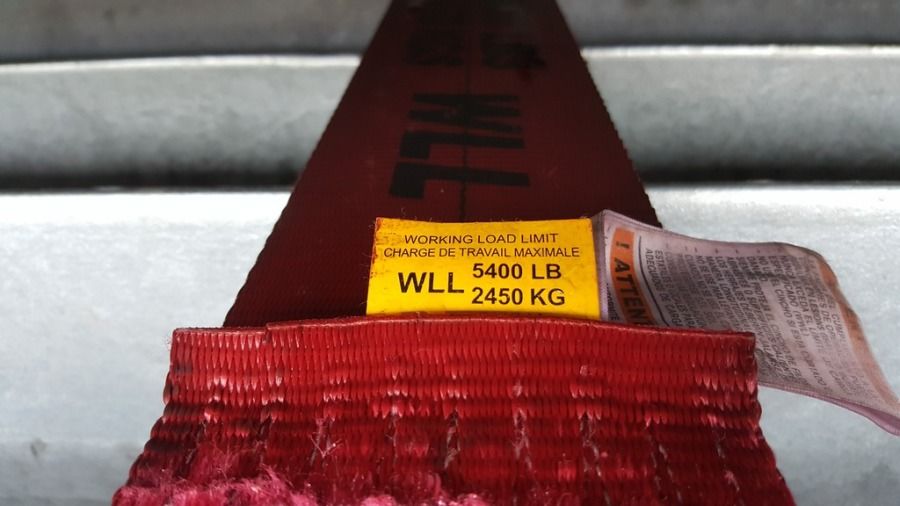
Quick correction. The WLL of a 4" strap is only 4000# unless it has the tag sewn on it like the photo above. Without that tag visible, the rating defaults back to 4K.
That is true, but if it doesn't have the tag on it I put it out of service. I'm not going to be found playing around with a bunch of different WLL ratings when I'm standing there looking at a D.O.T. officer checking my work.
That is true, but if it doesn't have the tag on it I put it out of service. I'm not going to be found playing around with a bunch of different WLL ratings when I'm standing there looking at a D.O.T. officer checking my work.
Totally agree, was just bringing up the fact that it has to have the tag to meet 5400, 6600 or whatever rating it might be at. Plus, if a driver has to pick up a new strap and all they have is a standard 4", it's only gonna hold a value of 4K.
Was just trying to do my part to pass on valid info. I'll just be quiet and post pictures.
Robert I like that information and Old School I also agree with being safe on the straps I am definitly terrified of getting any points on my CDL. Robert that was something I had no idea about so thank you. Like always keep posting pics and explanations very educational!
CDL:
Commercial Driver's License (CDL)
A CDL is required to drive any of the following vehicles:
- Any combination of vehicles with a gross combined weight rating (GCWR) of 26,001 or more pounds, providing the gross vehicle weight rating (GVWR) of the vehicle being towed is in excess of 10,000 pounds.
- Any single vehicle with a GVWR of 26,001 or more pounds, or any such vehicle towing another not in excess of 10,000 pounds.
- Any vehicle, regardless of size, designed to transport 16 or more persons, including the driver.
- Any vehicle required by federal regulations to be placarded while transporting hazardous materials.

I would like to add that buying some extra 4 in ratchets with flat hooks and with chains and have 2in ratchets with flat hooks and with chains. Investing in some good stake pocket holders for those times your load happens to stack directly over one. Buy an extra winch bar cut in half and use for products like sheetrock that can easily be damage from over tightening. Get a good pair of steel toe boots. I got 2 pair just in case one gets wet I have a spare to change into, one looks like hiking boots and the other looks like walking shoes. Get a good pair of rain boots cause your time will come for load, unloading, and tarp/untrapping in rain. Invest in a good strap winder if one is not provided. For the corners protectors that are put on loads build a PVC pipe 5ft or so with a T fitting on top with a slit to fit the corner protectors. Have a small tool kit on hand for fixing winches and other minor things.
HOS:
Hours Of Service
HOS refers to the logbook hours of service regulations.New Reply:
New! Check out our help videos for a better understanding of our forum features

















Preview:
This topic has the following tags:
TMC Transportation Advice For New Truck Drivers Flatbed High Road Training Program Load Securement Photos Truck Equipment







 TT On Facebook
TT On Facebook
Ok then I will do just that C.T. And thanks Charlie Mac I will keep that in mind! Tractor Man I have started reading through the Cargo Securement area on here as well, thank you for that! Advice is great and I found that, a lot of the Flatbed Variety posters where people who were doing it everyday and I thought that was just awesome! So I can't wait to see how much advice and teaching will occur in this thread! Again thank you C.T.! Thank you Charlie Mac! I will be back to check for more replies!